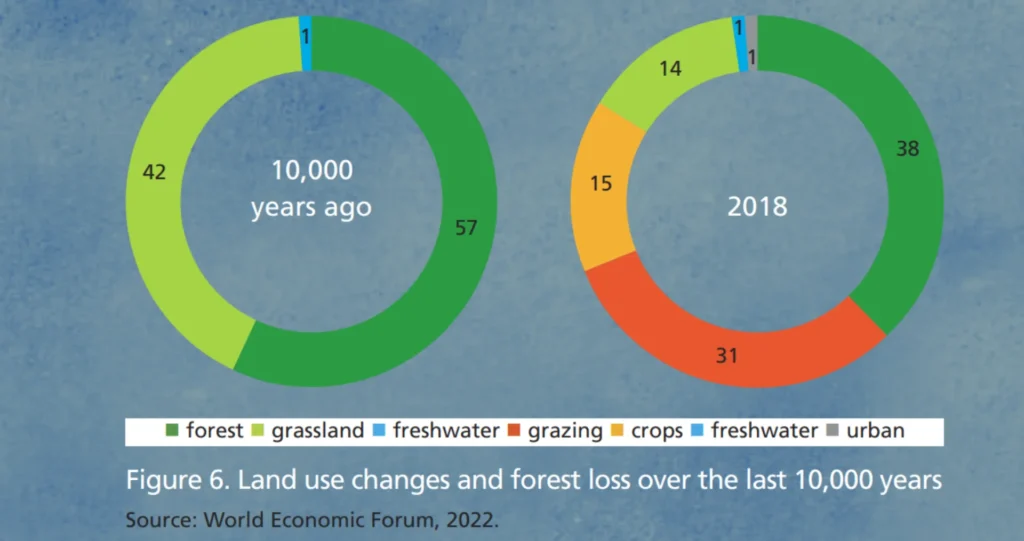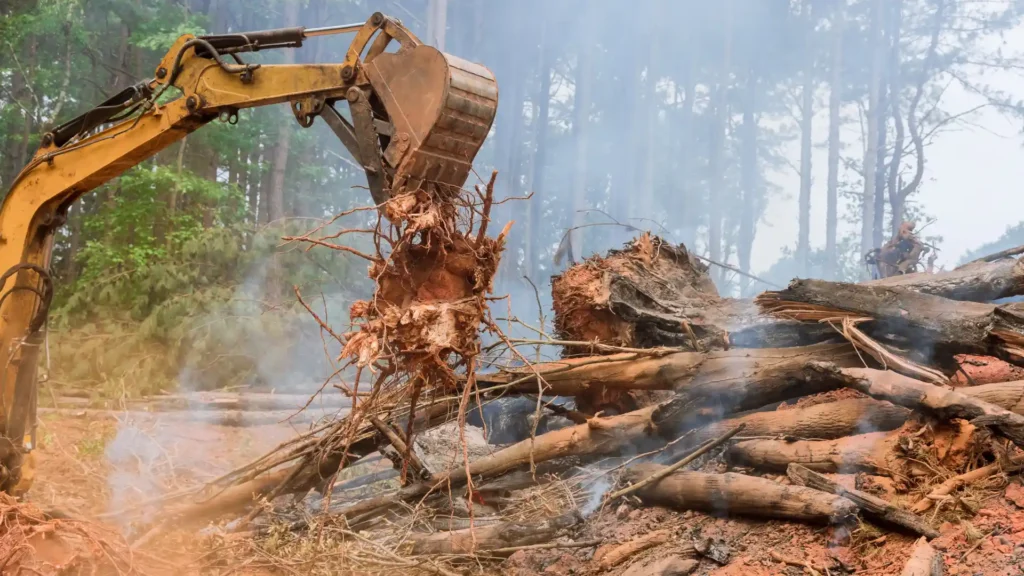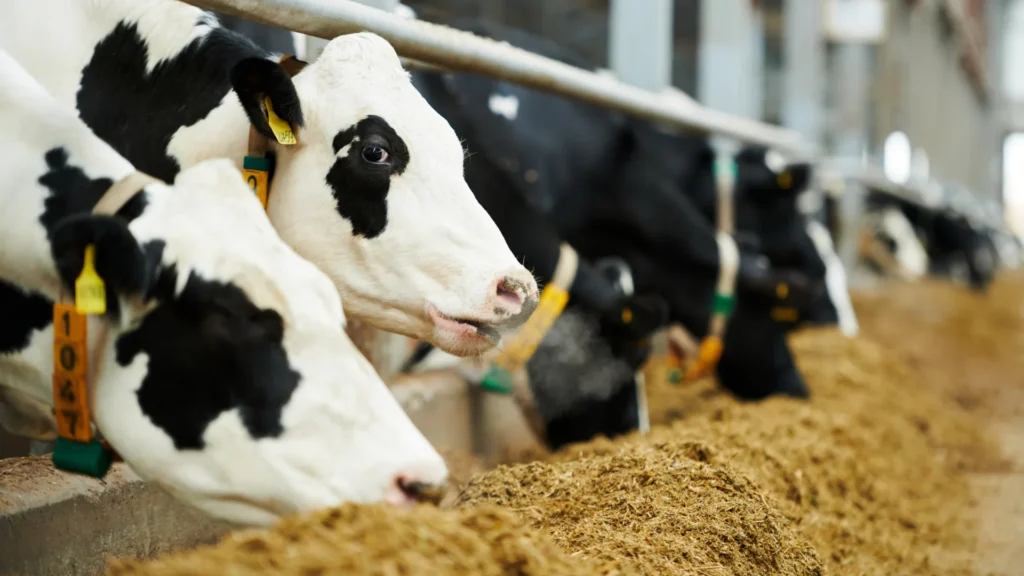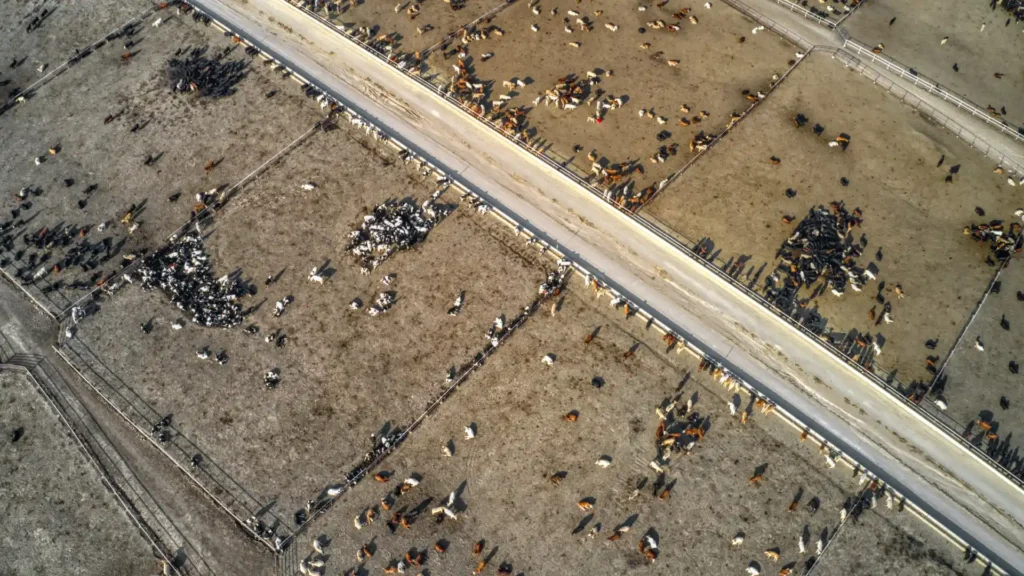Introduction
About 70 per cent of the Earth’s surface is covered with water and the remaining 30 per cent is land. Nearly 20 per cent of the land is ‘barren’, meaning it’s hard or impossible for people to live and grow crops there (such as deserts) and 10 per cent is ice glaciers – the majority in Antarctica.1https://www.weforum.org/agenda/2022/04/forests-ice-age/
The rest is what we call ‘habitable land’ – land where people can live. People have been changing and reshaping the world’s habitable land for thousands of years, clearing forests and grasslands to grow crops and farm animals. A planet of grasslands and forests has become a planet of farms.
Find out more
How farming shaped the planet
The diagram below shows how ten thousand years ago, 99 per cent of the world’s habitable land was either forest or grassland – the remaining one per cent was taken up by freshwater rivers and lakes. Since then, humans have cleared two-thirds of wild grasslands and one-third of the world’s forests. These have been replaced with farmland.1https://www.weforum.org/agenda/2022/04/forests-ice-age/ This change of land use has come at a huge cost to the planet’s biodiversity and lies at the heart of the climate crisis.

Land use in Uganda

As a result of Uganda’s population growth, growing towns and cities, and some Ugandans earning more money, the demand for meat and dairy is likely to sharply rise in the coming years. The United Nations (UN) estimates that by 2050, the demand for meat and milk products in Uganda will more than double.2https://www.fao.org/3/ca7009en/CA7009EN.pdf This is terrible news for the Uganda’s natural environment.
To produce these animal products, land that was once beautiful and iconic savannah and forest – and a home to Uganda’s majestic wildlife – is being turned into farmland. This is stripping the wildlife of its natural habitat and making it harder for the land to support life. As land is turned into farms, it means the wildlife must squeeze into a smaller area where there is more competition with other animals and less food for them to eat.
In the last one hundred years, Uganda has lost 42 per cent of its forests, decreasing from 54 per cent to 12 per cent in 2017.3https://illuminem.com/illuminemvoices/deforestation-in-uganda-causes-and-recommendations According to the UN, between 1990 and 2015, Uganda lost around 63 per cent of its remaining forest cover.4https://www.fao.org/3/cb7080en/cb7080en.pdf If Uganda doesn’t take immediate action, it will lose all its forest in the next 25 years.5https://www.theguardian.com/global-development/2020/jun/29/cooking-up-a-solution-to-ugandas-deforestation-crisis-with-mud-stoves
It is also common for cattle ranchers to steal land from Queen Elizabeth National Park and use it for grazing beef cattle.6https://conbio.onlinelibrary.wiley.com/doi/abs/10.1111/cobi.12538?campaign=woletoc The National State of the Environment Report for Uganda 2014, attributes this to “the increasing demand of land for agriculture and fuel wood by the rapidly increasing population growth.”7https://nema.go.ug/sites/all/themes/nema/docs/FINAL%20NSOER%202014.pdf But the impact on Uganda’s habitats wouldn’t be so harmful if, instead of farming animals, the country focused on growing crops for people to eat directly.
A wasteful system

One of the main reasons why animal agriculture is such a wasteful use of land is because feeding crops to farmed animals to get meat and dairy doesn’t make sense.
For example, to get just one kilogram of beef from a cow, you have to feed them 25 kilograms of crops – and only a tiny amount of protein and calories in the crops gets converted to beef.8https://www.chathamhouse.org/sites/default/files/2022-10/2022-10-14-food-systems-climate-biodiversity-harwatt-et-al.pdf In other words, you have to put a lot of food into an animal but get very little back. It would be better if humans just ate the crops instead of the cow!
Find out more
When plant foods are fed to animals, most of the protein and energy they contain are used by the animal just to stay alive, not to produce more meat. As ‘food production machines’ animals are extremely polluting and inefficient. However, if we stopped eating animals and used the land to grow crops for humans to eat, there would be enough food to feed another four billion people with 75 per cent less farmland required. Win win!
Feed people not farmed animals

In November 2022, the world’s population reached eight billion. Growing food for people to eat, rather than feeding it to farmed animals, could feed an extra four billion people. That’s a total of 12 billion, with less damage to the environment.9Cassidy ES, West PC, Gerber JS and Foley JA 2013. Redefining agricultural yields: from tonnes to people nourished per hectare. Environmental Research Letters. 8, 3
Across the world, 42 per cent of cereal crops is used for feeding farmed animals, and in many countries, even more is used.(8) This is wasteful, unsustainable and a “staggeringly inefficient use of resources”.10https://www.chathamhouse.org/2014/12/livestock-climate-changes-forgotten-sector-global-public-opinion-meat-and-dairy-consumption If these crops were used to feed people instead of farmed animals, no one would go hungry ever again.
Find out more
Meat = more land, more pollution, less food
Top scientists revealed that meat, fish, dairy and egg production uses around 80 per cent of the world’s farmland and produces a whopping 60 per cent of food’s greenhouse gas emissions.11Poore J and Nemecek T. 2018. Reducing food’s environmental impacts through producers and consumers. Science. 360 (6392) 987-992 But these animal products only provide 18 per cent of the calories we eat and 37 per cent of the protein. That’s a lot of wasted land and pollution with very little nutritional benefit! In fact, one of the scientists was so shocked by how damaging animal farming is, that he went vegan himself!
Another study calculated that by not eating meat, you can cut the impact of your food on the environment by an impressive 70 per cent.12https://www.nature.com/articles/s43016-023-00795-w And, “compared to the high meat-eaters, vegans also had just 25 per cent of the dietary impact for land use.”13https://www.sciencealert.com/oxford-scientists-confirm-vegan-diet-is-massively-better-for-planet
Farms the size of Africa

The world’s taste for meat and dairy is growing faster than its taste for cereal and if we don’t take urgent action to eat less meat, by 2050, more crops will be fed to animals than people.10https://www.chathamhouse.org/2014/12/livestock-climate-changes-forgotten-sector-global-public-opinion-meat-and-dairy-consumption If everyone in the world ate the unhealthy meaty diet of rich, over-developed countries, we would need extra land the size of Africa and Australia combined to provide enough meat.14Eisen MB and Brown PO. 2022. Rapid global phaseout of animal agriculture has the potential to stabilize greenhouse gas levels for 30 years and offset 68 percent of CO2 emissions this century. PLoS Climate. 1 (2) e0000010
On the other hand, if people stopped eating meat, dairy and other animal products, global farmland could be reduced by more than 75 per cent.11Poore J and Nemecek T. 2018. Reducing food’s environmental impacts through producers and consumers. Science. 360 (6392) 987-992 No grazing land would be needed and less land would be needed to grow crops, as humans would be the only ones eating them. Some cropland once used for animal feed would be needed to grow crops for people, but there would be an overall massive decrease in land use and we would be able to produce enough food to feed everyone.
If we stopped eating meat and switched to a plant-based diet, forests and grasslands and their wildlife would be saved, people would be healthier, and no one would need to starve. It’s time to stop ignoring the science; it’s time to go vegan!
References
References
- 1
- 2
- 3
- 4
- 5
- 6
- 7
- 8
- 9Cassidy ES, West PC, Gerber JS and Foley JA 2013. Redefining agricultural yields: from tonnes to people nourished per hectare. Environmental Research Letters. 8, 3
- 10
- 11Poore J and Nemecek T. 2018. Reducing food’s environmental impacts through producers and consumers. Science. 360 (6392) 987-992
- 12
- 13
- 14Eisen MB and Brown PO. 2022. Rapid global phaseout of animal agriculture has the potential to stabilize greenhouse gas levels for 30 years and offset 68 percent of CO2 emissions this century. PLoS Climate. 1 (2) e0000010

